Panasonic 7-14mm f/4 Lumix G Vario Micro Four Thirds
Panasonic 7-14mm f/4 Lumix G Vario Performance
At 7mm and maximum aperture, sharpness in the cetre portion of the frame is outstanding, with clarity towards the edges being very good. Stopping down doesn't improve the quality across the frame much, only reducing the sharpness in the centre due to the effects of diffraction and very good sharpness across the frame can be achieved with apertures between f/4 and f/8, with good sharpness across the frame being possible at f/11.The same characteristics are present with the lens zoom to 10mm alos, with very high centre sharpness at maximum aperture and very good sharpness towards the edges between f/4 and f/8.
Finally at 14mm, similar high levels of sharpness are present in the cetre of the frame at maximum aprture with very good sharpness towards the edges of the frame. Peak sharpness across the frame is achieved at f/5.6 for this focal length, where sharpness in the centre is outstanding and approaches excellent levels towards the edges.
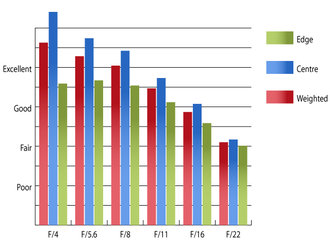 Resolution at 7mm | 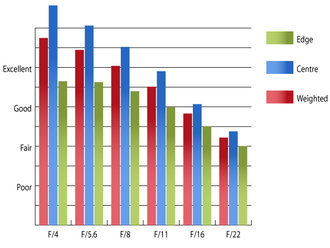 Resolution at 10mm | |
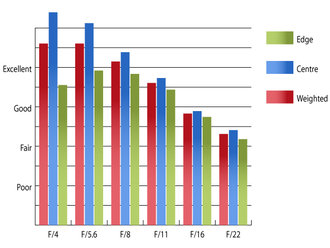 Resolution at 14mm | How to read our chartsThe blue column represents readings from the centre of the picture frame at the various apertures and the green is from the edges. Averaging them out gives the red weighted column.The scale on the left side is an indication of actual image resolution. The taller the column, the better the lens performance. Simple. For this review, the lens was tested on a Panasonic Lumix DMC-G1 using Imatest. |
Levels of chromatic aberration are very low for a lens of this type, with fringing only just exceeding half a pixel width with the lens stopped down to f/22 throughout the zoom range. This low level should pose few issues, even in large prints or harsh crops from near the edges of the frame.
Falloff of illumination towards the corners of the frame at maximum aperture is quite prominent. At 7mm the corners are 2.9 stops darker than the image centre at f/4 and at 14mm this drops to 2.61 stops darker. Stopping the lens down to f/8 results in visually uniform illumination throughout the zoom range.
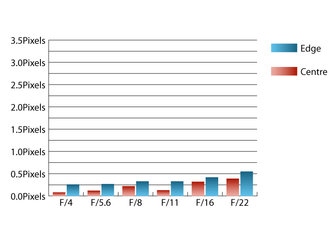 Chromatic aberration @ 7mm | 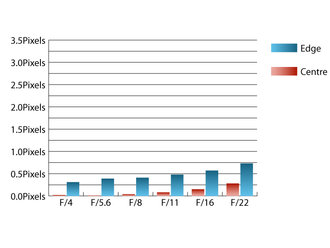 Chromatic aberration @ 10mm | |
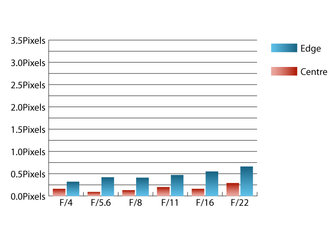 Chromatic aberration @ 14mm | How to read our chartsChromatic aberration is the lens' inability to focus on the sensor or film all colours of visible light at the same point. Severe chromatic aberration gives a noticeable fringing or a halo effect around sharp edges within the picture. It can be cured in software.Apochromatic lenses have special lens elements (aspheric, extra-low dispersion etc) to minimize the problem, hence they usually cost more. For this review, the lens was tested on a Panasonic Lumix DMC-G1 using Imatest. |
Distortion is very well controlled for a lens with such a wide field of view. At 7mm 1.66% barrel distortion is present and at 14mm Imatest detected 0.366% pincushion distortion. Unfortunately the distortion pattern has a slight wave to it, which can make correcting straight line sin image editing software tricky.
Add your message
Login required
Please login here or if you've not registered, you can register here. Registering is safe, quick and free.
Please login here or if you've not registered, you can register here. Registering is safe, quick and free.
photodo Stats
1102 lenses
428 MTF tests
74 in-depth photodo reviews
100+ users join each day
Help the lens community by reviewing or rating a lens today via our lens search
428 MTF tests
74 in-depth photodo reviews
100+ users join each day
Help the lens community by reviewing or rating a lens today via our lens search
Latest Lens Reviews
- Chinon 28mm f/2.8 Vintage Lens Review
- Canon EF 70-200mm f/4L IS II USM Lens Review
- Samyang AF 85mm f/1.4 EF Review
- Sigma 70mm f/2.8 DG Macro Art Review
- Samyang AF 24mm f/2.8 FE Review
- Meike 50mm f/1.7 Review
- Tamron 70-210mm f/4 Di VC USD Review
- Lensbaby Burnside 35mm f/2.8 Review
- Asahi Super Takumar 50mm f/1.4 Review
- Asahi Super-Multi-Coated Takumar 135mm f/3.5 Review
